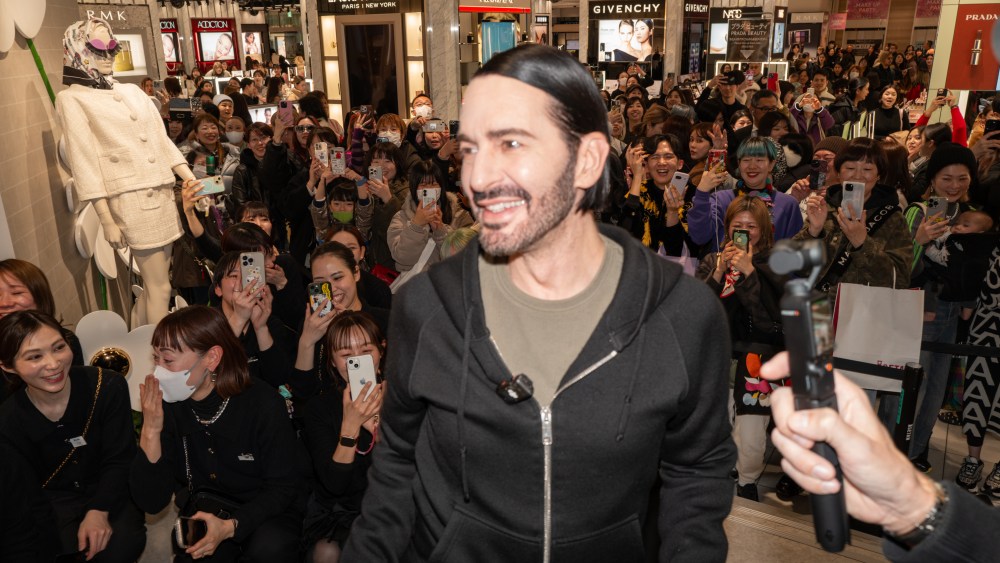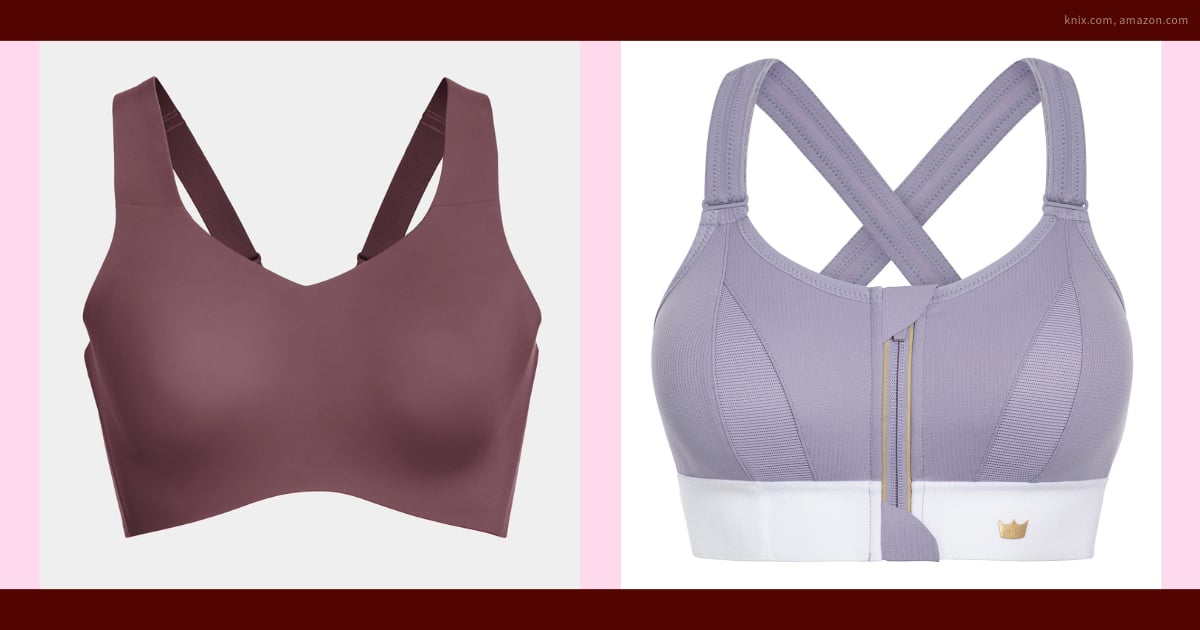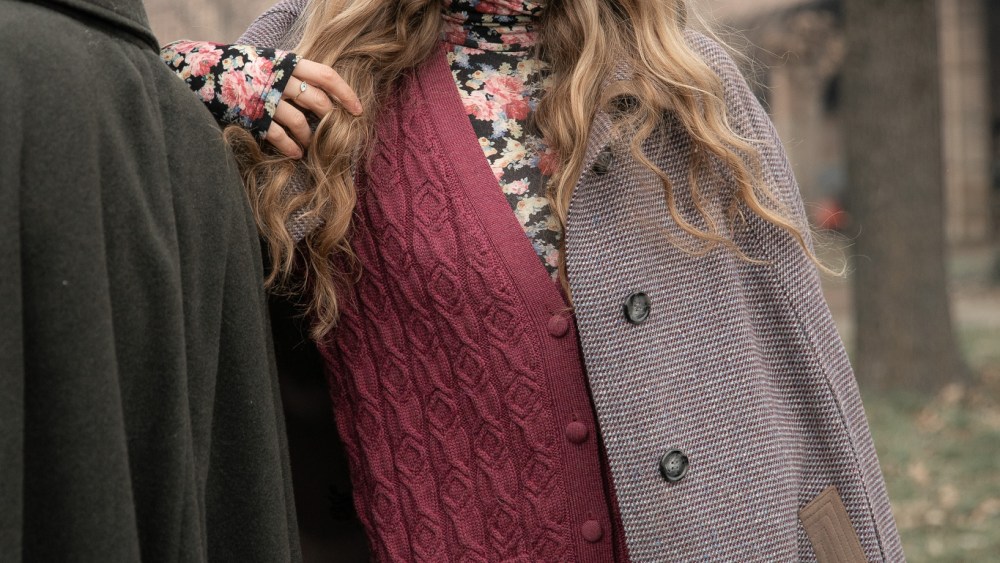Isetan welcomed Marc Jacobs with open arms to Tokyo this week to celebrate the exclusive House of Marc Jacobs that debuted at the flagship.
In a similar distribution deal that Jacobs has with Bergdorf Goodman in the U.S., the designer will exclusively sell Marc Jacobs Runway to the Isetan flagship in Tokyo.
Fresh off his runway show at the New York Public Library on Feb. 3, the designer flew to Tokyo last Friday to celebrate the launch of the new partnership, where he took over the premier 861-square-foot space on the first floor of Isetan for a week with a fully immersive House of Marc Jacobs installation. It will be followed by a longer-running space on the third floor that will feature the full range of Marc Jacobs ready-to-wear and accessories.

The famed Japanese department store celebrated Jacobs’ visit with a party Monday and an intimate dinner Wednesday. It’s the first time Jacobs has been back to Japan in 19 years.
You May Also Like
The space launched on Wednesday with people lining up before Isetan opened to see the House of Marc Jacobs. Jacobs arrived to the space around 1:30 p.m. and met with executives from Isetan and LVMH Japan, and a few top clients. Jacobs then went to greet the guests at the first-floor stage installation.
The completely interactive space highlights the entire world of Marc Jacobs, including an animatronic Jacobs that taps his nails on the table. Later that evening, at a private dinner hosted by Kazunari Shirai, Jacobs’ return to Tokyo was celebrated by guests including Takashi Murakami, Tadanobu Asano and Vogue Japan’s Tiffany Godoy.

Before leaving for Tokyo, Jacobs spoke with WWD about his return to Japan and the impetus behind doing an exclusive partnership in Japan with Isetan.
“We decided [on Isetan] because we have some history, and it’s the best fashion store in Tokyo,” said Jacobs in a Zoom interview. “I haven’t been there in a very long time, but I also trust the people I work with. They think it’s a great place for us to be. It has the most sophisticated offer in terms of fashion, and it always comes down to if you could choose one thing, what would it be? History and education inform our choice.”
Asked how Marc Jacobs Runway is performing at Bergdorf’s — where it’s had an exclusive global distribution deal since 2021 — Jacobs said, “I don’t know. Successful to me is very different than what it is to other people. I define success as being highly visible. We never really went into the Bergdorf situation as this cash-register-driven expectation. It was a place for people to see the collection, and they could purchase some pieces or order through Bergdorf’s. Our decision was made on the prestige of Bergdorf’s, but also how well they service their customers. That way we could supply and cater to someone who is genuinely interested in having one of the pieces from the runway made for them,” he said.
Yumi Shin, chief merchandising officer of Bergdorf’s, said, “We’ve seen very positive responses to the Marc Jacobs Runway collection since we launched it exclusively in 2021. The line’s exceptional craftsmanship and whimsical proportions have resonated with the customer in search of something distinctive and unconventional.”

At Bergdorf’s, for example, Marc Jacobs Runway retails from roughly $995 to $6,000, with special pieces retailing from $10,000 to $15,000.
When he signed the BG deal in 2021, Jacobs told WWD that the retailer had been a supporter of his since the mid-1990s, following his exit from Perry Ellis. “I could not imagine a better partnership between two New York City brands,” he said at the time.
Jacobs has been showing a series of extreme silhouettes on the runway, and one media outlet recently reported that Jacobs wasn’t expecting people to actually wear his collection. When questioned about that, he acknowledged that if Bergdorf did this with every brand they carry [buying it and not expecting to sell it] it would be problematic on a business level.

“Bergdorf has the luxury and they also have the vision, and this is something that isn’t about money. This is about protecting creativity and having it available, but in a way that’s truly luxurious. It’s rare, it’s scarce, and we can make it available to you,” said Jacobs.
Jacobs also feels this rarity strategy is environmentally beneficial. “One of the things I wanted to get back to was [designing] high fashion and very expensive clothes that were free of the commercial constraints. Designers should do what they want and have complete freedom in terms of creativity, and also I didn’t like the idea of seeing many pieces out in the wild. If you bought something, it was more or less really limited. It’s very in line with the image of Bergdorf, it is special, it’s rare, you don’t see it everywhere.”
As for whether Isetan has similar beliefs, Jacobs said, “I don’t know. I know Bergdorf Goodman growing up in New York City and going for shopping visits with the grandmother. Culturally I know of Bergdorf’s being this unique specialty store in the U.S., I don’t really know culturally where it [Isetan] sits in terms of Japan.”
At Isetan, Jacobs is featuring the 2024 collection that he showed on the runway last July.
Jacobs said he believes the Isetan relationship is ongoing and it’s not just for one season. “The intention is always to establish a good relationship with people . . . . It’s everyone’s intention that it’s ongoing,” he said.

Asked if he knows if there are plans to do this with other cities, Jacobs said, “I don’t. I don’t know if the company does. This whole situation has been very organic. We had really only hoped to create a partnership with Bergdorf, and then I think at some point, it was discussed it would be nice to have another partner somewhere else. I mean, I’d love to be in Selfridges in London, at some point,” said Jacobs.
Isetan also carries the more commercial Marc Jacobs line, which Jacobs designs, as well as pieces of Heaven.
Currently, there are more than 130 Marc Jacobs [mainline] stores worldwide. The mainline is also sold at Bergdorf’s, Neiman Marcus, Dover Street Market, Saks Fifth Avenue, Fwrd, Ssense and Shopbop.
Jacobs said he prefers that Marc Jacobs Runway is featured in one Isetan store, not throughout the chain. “I don’t know if my thinking is in line with the people who are making the business grow,” he said.
When asked how he believes the Japanese customer will react to the Marc Jacobs Runway line, he said, “Well I don’t know. Again, I haven’t been there in a long time, but I always found that the culture that I was exposed to, the Japanese are lovers of fashion. I know there were some real avid Marc Jacobs collectors. I know they’ve been photographed in their room with tons of Marc Jacobs from past seasons. I always think that we have a very big fan base there, so I imagine the fans will be happy to see it there. I don’t know how much they’ll buy, but I think our presence in Tokyo and Japan has always been pretty visible and very good and much appreciated.”

As far as what he predicts will sell very well at Isetan, he said, “Very well might mean selling a few of each look, it’s all relative. But I can very much imagine some of the dresses being quite popular with the customers there, I can imagine some of the knit looks with a skirt being very popular. From what I remember, the customers like things that are pretty iconic in terms of the pieces that stand out from the collection. I’m sure Isetan’s buy reflects what the most popular pieces were. And I think since we’ve been doing this, we’ve been doing small collections, and we tend to repeat within the show the looks we feel most strongly about. I think it’s very strong to get behind a few of the looks that tell the story of what you’re thinking in a season, as opposed to a sea of looks where everything becomes merchandise, and it’s hard to decipher what the designer was saying. I kind of feel that anything they would have bought were things that were very much photographed and talked about,” said Jacobs.
He noted that with the way they’re working now, they’re very capable of producing things very quickly and can respond to the customer. “We have a small production, and do have the support of the suppliers we work with. I think it’s relatively straightforward how to produce these pieces in a relatively short period of time,” he said. The ready-to-wear pieces are made in New York. Knitwear and footwear are made in Italy. The bags are made in the U.S. and Italy.
Jacobs hasn’t considered a freestanding store for Marc Jacobs Runway. “I don’t think it will do very well,” he said.
Since Jacobs hasn’t been back to Tokyo in nearly two decades, he said he’s excited to explore the city. “I haven’t been in a really long time. I have been many times in my life. It’s a very stimulating, sometimes over-stimulating place to go. My husband (Charly Defrancesco) is coming with us on this trip and he’s never been. On my down time, it will be fun to go around with the Marc Jacobs team and Charly. I think we’ll have some nice dinners and I think we’ll see some nice galleries and do some fun shopping.” He said he’ll be gone for almost a week.

“I’m very grateful. I’ve been doing this for a long time. I feel very confident about the way we work now. I do guard our ability to be creativity free. I think that’s of great importance. The stores that are supporting us in that belief are obviously crucial to me and very important and I think give me hope that there is another way,” said Jacobs. LVMH continues to be an investor in Jacobs’ business.
Jacobs likes the idea of slowing down the whole process. “Everybody does not have to produce five seasons a year and endless number of looks each season and tons of markdowns and wastage of fabrics and inventory and all that other stuff. I know that game. We were part of that way of doing for so long. It just seems to be very outdated, especially for a smaller brand like us. I get it for some of the huge names at LVMH’s other brands, where they have the machine, not just the ability to produce but the machinery to advertise and promote. There are not that many houses that can really afford to do that properly. I’m very glad and grateful for the support from Bergdorf and Isetan. Eric Marechalle (CEO of Marc Jacobs International) really protects the runway, and believes in this idea of mine that it should be rare and exclusive,” he added.



